Shoulder Exercises
By Lee Hayward

|
Make Sure To Sign Up For My FREE Bodybuilding & Fitness Tips Newsletter!
Just type in your name and primary e-mail address below and you'll
be immediately enrolled to receive my information packed newsletter.
|
Shoulder Muscle Anatomy
The primary muscle of the shoulder is the deltoid (also know as the "delts"). It is the rounded cap over the point of your shoulder. There are three heads of the deltoid that insert into the upper arm bone. The anterior (front) head, the medial (side) head, and the posterior (rear) head.
Around the shoulder joint itself is a small bundle of muscles called the rotator cuff. These smaller muscles help to rotate the arm in its shoulder socket. Since these muscles are small relatively weak they can be injured easily. That is why it is essential to warm up well before working your shoulders or doing any activities that incorporate the shoulder joint.
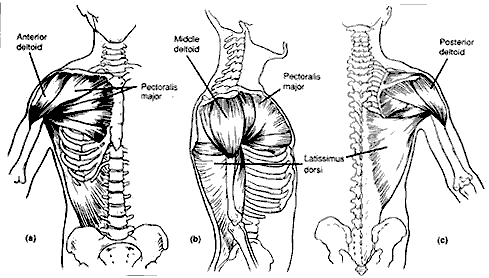
It is essential that when you do any exercise that you perform the movements correctly, if you don't you will receive less then optimum benefit from the exercise. It is very difficult to unlearn bad exercise habits, so it is best to learn the right exercise technique from the very start.
For each shoulder workout pick 3 of these exercises and do 4-5 sets (including warm up sets) for each exercise. You can vary the exercises you do for each shoulder workout.
Seated Barbell Press (also know as the "Military Press")
This is a basic shoulder exercise that works the anterior (front) delts and the triceps. It also works the upper chest and upper back as secondary muscles.
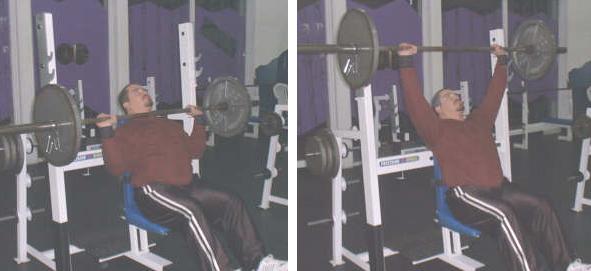
Sitting on an upright bench. Grab the barbell with a wider then shoulder width grip. Push the barbell directly upward until it is at arms length above your shoulders. Lower the barbell back to starting position. Repeat.
This exercise can be done lowing the barbell to the front or behind the head. But some people find that the behind the head version places more stress on the shoulder joints.
Seated Dumbbell Press
This exercise works the entire deltoid area and the triceps. Secondary stress is placed on the upper chest and upper back muscles.
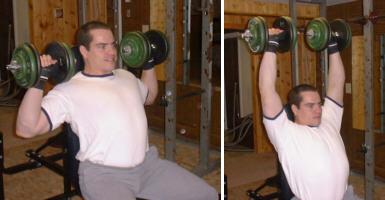
Sit on an upright bench. Grab 2 dumbbells and pull them to your shoulders. The palms of your hands should be facing forwards during the exercise. Keep your feet shoulder width apart.
Keeping your elbows directly under the dumbbells press them upwards until they are at arms length above your head. Lower the dumbbells back to the starting position. Repeat.
Side Lateral Raises
This exercise works the medial (side) deltoids. Secondary stress is applied to the front deltoids and the forearms.
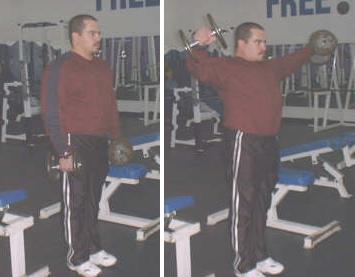
Grab 2 light dumbbells. Stand with your feet shoulder width apart. Hold the dumbbells just in front of your body with the palms of your hands facing each other. Keep a slight bend in your elbows.
Using your deltoid strength, raise the dumbbells out to the sides and upwards in a semicircular arc until they are just above shoulder level. Hold this position for a second to maximize the peak contraction in the deltoids. Lower the dumbbells back to the starting position. Repeat.
Tip - to really isolate your deltoids you can do this exercise seated on a bench. This will eliminate any body motion.
Front Lateral Raises
This exercise works the font (anterior) deltoids. Secondary stress is applied to the side deltoids and the forearms.
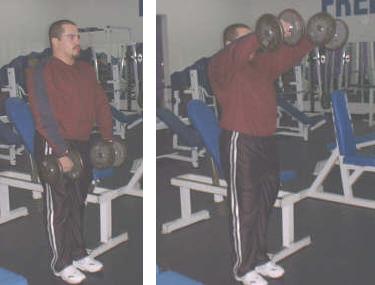
Grab 2 light dumbbells. Stand with your feet shoulder width apart. Hold the dumbbells at your sides with the palms of your hands facing each other. Keep a slight bend in your elbows.
Using your deltoid strength, raise the dumbbells to the front and upwards in a semicircular arc until the dumbbells are just above shoulder level. Hold this position for a second to maximize the peak contraction in the deltoid. Lower the dumbbells back to the starting position. Repeat.
Tips - to really isolate your deltoids you can do this exercise seated on a bench. This will eliminate any body motion. For variety you can do this exercise with a barbell instead of dumbbells.
Bent Lateral Raises (also known as "Bent Dumbbell Flyes")
This exercise works the rear (posterior) deltoids. Secondary stress is applied to the upper back muscles and forearms.
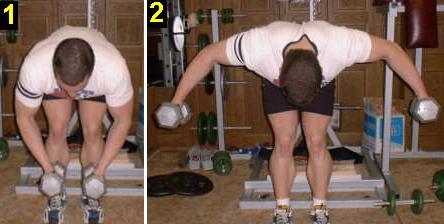
Grab 2 light dumbbells. Bend over at the waist with your feet shoulder width apart. Keep a slight bend in the knees to prevent stain on the lower back. Hold the dumbbells at arms length in front of you with the palms of your hands facing each other. Keep a slight bend in your elbows.
Using your rear deltoid and upper back strength, raise the dumbbells to the back and upwards in a semicircular arc as far as you can. Hold this position for a second to maximize the peak contraction in the rear deltoids. Lower the dumbbells back to the starting position. Repeat.
Tips - to really isolate your deltoids you can do this exercise lying face down on a high exercise bench. This will eliminate any body motion.
Barbell Shrugs
This exercise works the trapezius muscles and secondary stress is placed on the forearms. Technically the trapezius is a back muscle, but a lot of bodybuilders like to do barbell shrugs with their shoulder workouts.
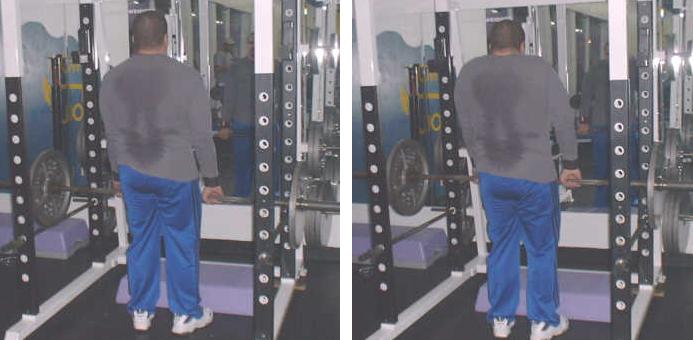
Place a barbell on the floor at your feet, bend over and grab the bar with your hands shoulder width apart. Bend your legs and lift barbell until it is at arms length in front of you (similar to the deadlift exercise). You can use a power rack or squat rack to help get the barbell up to this position.
Keep a slight bend in your knees to take stress off your lower back. Without moving your arms shrug the barbell upwards as high as you can. Squeeze your traps for a second at the top of the movement to maximize the peak contraction. Lower the barbell back to starting position. Repeat.
Tips - for variety you can do this exercise with dumbbells instead of a barbell. If you are using heavy weights you should wear a weight lifting belt to support your lower back.
Seated Dumbbell Press On The Stability Ball
This exercise works the entire deltoid area, but because you have to balance yourself on the ball it focuses on developing the small stabilizer muscles.
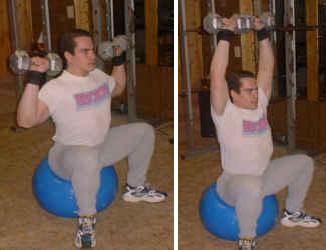
Grab a pair of light dumbbells. Sit upright on the stability ball. Pull the dumbbells up to your shoulders. The palms of your hands should be facing forwards during the exercise. Your feet should be flat on the floor. (Note: the closer you place your feet the harder it is to balance on the ball).
Keeping your elbows directly under the dumbbells press them upwards until they are at arms length above your head. Lower the dumbbells back to the starting position. Repeat.

|

